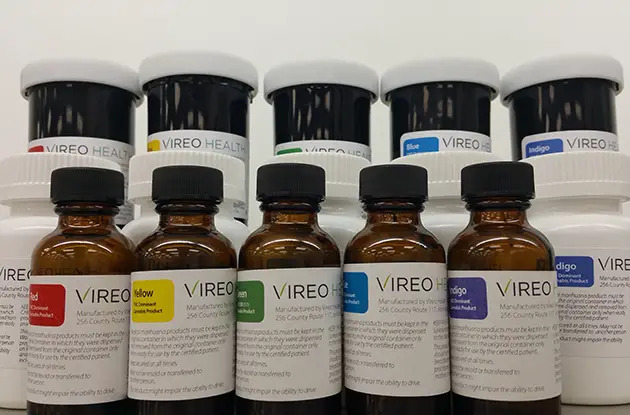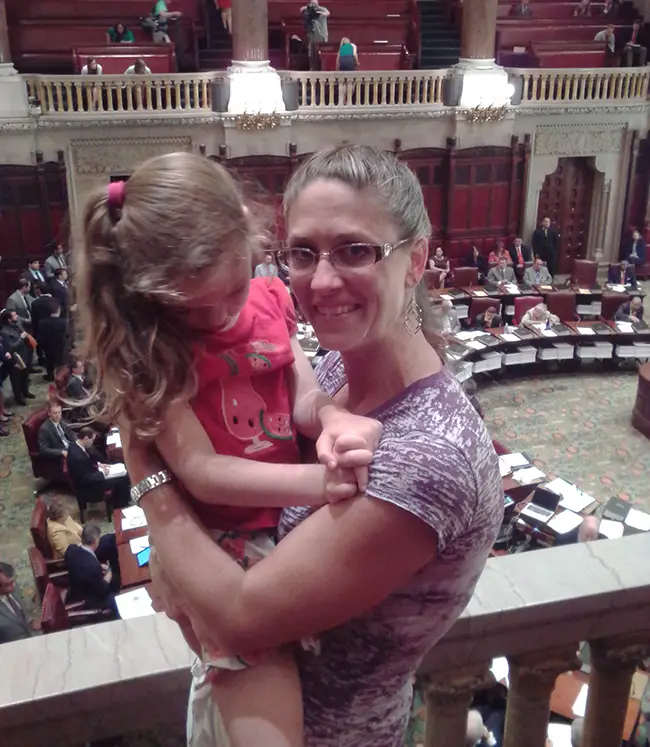What it’s like to provide your child with medical marijuana in New York.
Twice a day—once with breakfast, and once again at dinner—Melissa Hilt administers medicine to her 9-year-old daughter, Haley. Hilt uses a syringe to measure out a precise dosage, and gives it to Haley mixed in her food. It’s a normal, everyday scene for a child who needs medication, with one big difference: The medicine Haley is ingesting is a coconut oil compound that contains extract from the marijuana plant. A resident of East Schodack in Rensselaer County, Haley is among the first New York residents to take advantage of the state’s recent legalization of medical marijuana.
Haley has severe intractable epilepsy. She can’t walk or talk, and is incontinent. Her first seizure was at 4 weeks old; since then, she seized at least once daily. But in the months since Haley started taking medical marijuana, she’s improved tremendously. “Within 24 hours of her first dose,” Hilt says, Haley “was more alert, bright in the best way.” She has just two or three seizures each week, compared to the seven to 10 she experienced prior to the drug.
Before she began taking medical marijuana, “we were never really sure what Haley knew, and what she didn’t.” Now, she’s able to communicate using an eye gaze computer. Hilt describes Haley as making “huge, huge gains” due to the medication. Haley can now stand on her feet and even ride a tricycle at school. In fact, “she loves to stand with support and dance,” her mom says. With the help of a walker-like device, Haley can walk down the hallways at school.
Haley is able to legally take medical marijuana thanks to New York’s legalized medical cannabis program, which took effect at the beginning of this year. New York joins the District of Columbia and 24 other states—including Connecticut and New Jersey—which have passed laws allowing use of marijuana in some form for medical purposes. The new laws, in addition to those in a handful of states that have legalized or reduced punishment for recreational marijuana use, come as public opinion has shifted dramatically. A 2015 survey from the Pew Research Center found that 53 percent of people believe marijuana should be legalized. That may seem like a slim majority—and it is—but just a decade ago, in 2006, a similar survey from Pew found that only 32 percent believed marijuana should be legalized.
RELATED: Find Special Needs Services Near You
Risks, Side Effects—And Benefits
Still, if you came of age in the unequivocal “Say no to drugs” era, when marijuana was labeled a gateway drug, the idea of children being recommended medical marijuana may cause trepidation. Hilt, however, has no regrets or reservations about the treatment method for Haley. Side effects are familiar to Haley: Steroid injections caused a heart murmur; a special high-fat diet aimed at reducing seizures caused Haley to go into liver failure; benzodiazepine, a tranquilizer used to reduce seizures, “zombified” Haley. Once, a medication caused her to sleep for 72 hours straight. In contrast, the coconut oil compound that’s used as a delivery agent for the cannabis treatment can sometimes cause Haley to get constipated. “When you’re looking at the side effects of the other medications that are out there, it’s nothing in comparison. Honestly, part of me wishes I could have tried it before we put her little body through all of these horrible things, to see if it would have worked then,” Hilt says.
The American Academy of Pediatrics sounds a more cautionary note. In a policy statement issued in March 2015, the AAP points out that there is ample documentation on “the adverse effects of marijuana” on adolescents as well as a lack of “published studies on the use of medicinal marijuana or pharmaceutical cannabinoids in pediatric populations.” As well as all the well-known side effects—including reduced attention span, short term memory, coordination, and judgment—the AAP also points out that “new research has also demonstrated that the adolescent brain, particularly the prefrontal cortex areas controlling judgment and decision-making, is not fully developed until the mid-20s, raising questions about how any substance use may affect the developing brain.”
Still, while opposing medical marijuana outside of the oversight and regulation of the U.S. Food and Drug Administration, “the AAP recognizes that marijuana may currently be an option for cannabinoid administration for children with life-limiting or severely debilitating conditions and for whom current therapies are inadequate.”
Against this backdrop of increased accessibility of medical marijuana, at least in some states, the federal government continues to classify marijuana as a Schedule I drug, alongside LSD, heroin, and ecstasy. The Drug Enforcement Agency defines these drugs as having “no currently accepted medical use and a high potential for abuse.” These Schedule I drugs are considered “the most dangerous.” It’s an undeniably complex landscape, and this, perhaps, is why New York’s medical marijuana program has been implemented with tight regulations.
Stephen Dahmer, M.D., the Chief Medical Officer at Vireo Health of NY, one of five organizations approved to dispense medical marijuana in the state, agrees that there are undeniable risks involved with medical marijuana. “Any physician that reads the literature about children or anyone under 21 and THC [a part of the marijuana plant] knows that caution has just been amplified a thousandfold,” he says. But for children such as Haley—people with intractable disease and extreme pain and discomfort—these risks may be worth it. “When these children arrive at our dispensary, this is one of their last hopes,” Dr. Dahmer says.
New York’s Cautious, Medical-Led Program
How do children—or any patients—get to Vireo or the other dispensaries in New York? The journey isn’t easy. The first New York dispensaries opened in January 2016. You may be imagining storefronts festooned with decorative marijuana leaves, Mason jars stuffed full of pot, boxes of pre-rolled joints, or plastic-wrapped cannabis-laced cookies, brownies, and other edibles. Erase that image: New York’s implementation of legalized medical cannabis differs sharply from states with more lenient, and lower regulated, programs (ahem, California). In New York state, no wink-wink, nudge-nudge diagnosis will get you access to medical marijuana. The program is tightly regulated and cautious. Dr. Dahmer describes New York’s program hewing “very closely to a medical model.”
Vireo’s work with doctors, and the state’s program, mimics the general practices that govern doctors’ habits and style, Dr. Dahmer says. “Anything we do—in our practice, and oftentimes in our lives—is done with a lot of caution. We want to always take the safest route…and make sure that our patients are protected and that some unforeseen circumstance doesn’t catch us by surprise.”
A Snapshot of New York’s Medical Marijuana Law

|
A stringent registration process: Even patients who suffer from those conditions do not have an easy path to a recommendation. Only registered doctors—who meet certain set criteria, and have taken a four-hour class—can register with New York’s Medical Marijuana Program and recommend marijuana. Fewer than 600 doctors had done so by mid-July, according to the state. Patients have to either find one of these doctors (there is a registry, but doctors are not required to add their names to it and some prefer to keep their participation quiet) or ask their doctor to join the program. Only then can patients get a recommendation. Currently, there are more than 5,000 patients certified.
Licensed pharmacists: Only licensed pharmacists can fulfill the recommendations; currently, there are five medical marijuana dispensaries in the state, each with four or five locations.
Extract only: New York limits the forms medical cannabis can take. There is no form of regulated, medical marijuana available for sale in the state that can be smoked or eaten (no medical cannabis brownies). Instead, it is sold in forms such as pills, vaporizers ingested via inhaler, and oils.
RELATED: Find Special Needs Therapies Near You
Haley’s Path to Medical Marijuana
In her two daily doses, Haley takes what is known as a “high CBD, low THC” strain of marijuana. CBD, which stands for cannabidiol, is non-psychoactive, and cultivated for its pain-relieving, anti-inflammatory qualities, while THC, or tetrahydrocannabinol, is the mind-altering part of the marijuana plant. Put another way, THC is the part of the marijuana plant that makes you feel stoned while CBD is the medicinal part of the plant.
Several years ago, Hilt became interested in the possibility of medical marijuana as a treatment option for Haley: Her family doctor had watched a special about Colorado’s Stanley brothers, famous for creating a high CBD, low THC strain called Charlotte’s Web, that reduced its namesake’s seizures. This prompted Hilt to begin researching how high CBD strains could help people with epilepsy. A registered nurse, Hilt read the research carefully, and then began lobbying at the capital. For more than six months, “we were lobbying and trying to get senators to listen to us and support our cause,” Hilt remembers.
Hilt and her daughter were there the day the program passed, and when the program went live on a Friday, Haley was certified the following Wednesday. Because Haley was on a form of benzodiazepine that’s affected by CBD, Haley had to decrease her dosage of benzodiazepine before she could begin taking medical marijuana. She began taking the high CBD, low THC strain in February. The transformation has been huge: “She is soaring,” says Hilt. “Haley is doing phenomenally.”
|
Melissa Hilt holds Haley in the New York State Senate chambers on the day that legislators voted to legalize medical cannabis. |
What’s Next?
Medical cannabis remains—even after legalization in many states—in a complicated position. Laws differ from state to state, even in ones that have legalized the plant. Federally, it remains illegal, even if the government’s guidance is essentially to prosecute major offenses (drugged driving or possession on federal property, for instance) and to allow states to enforce their own regulation.
That makes for an uneasy balancing act, with results that can be frustrating. For one, medical marijuana, still illegal federally, is not covered by insurance. Hilt pays for Haley’s medical marijuana—which costs nearly $400 a month—with the help of fundraising done by her church and community.
Beyond the expense, Hilt chafes at the federal government’s slow move to reclassification, which would allow drug trials, and feels frustrated that truly sick people cannot get access to a potentially helpful drug. “It’s almost like we’re being held hostage to the pharmaceutical companies when there’s this plant out there that can really and truly help so many people.”
And while the AAP opposes legalization, concerned that it will increase children and teen’s access to the drug, the organization also advocates for studying the impact of new laws, and calls for marijuana to be reclassified as a Schedule II drug (a classification that includes Adderall, OxyContin, cocaine, and methamphetamine, among others). This classification would allow “research and development of pharmaceutical cannabinoids and supports a review of policies promoting research on the medical use of these compounds.” Dr. Dahmer says he is also “interested in helping to support or promote research,” especially given the tremendous impact he sees daily on children and their families.
For parents whose children face one of the 10 eligible conditions, Hilt’s advice is twofold. First, educate yourself. “That’s the number one recommendation I have for other parents,” Hilt says. Dig into the slim research currently available, review anecdotal evidence, and reach out to dispensaries for their insights. And then, “Fight for your kid.” Medical marijuana is “not something our government should say we can or can’t have. This is something our physicians should determine, not the government. Call your legislators, call your senator, and tell them, I want this available for myself, for my children, for whomever.”
Main image: Haley Hilt, a 9-year-old whose quality of life has improved dramatically since she started taking medical marijuana after it was legalized in New York
Courtesy Melissa Hilt
RELATED:
Find Health Care Providers Near You
10 Tips for Advocating For Your Child with Special Needs





















